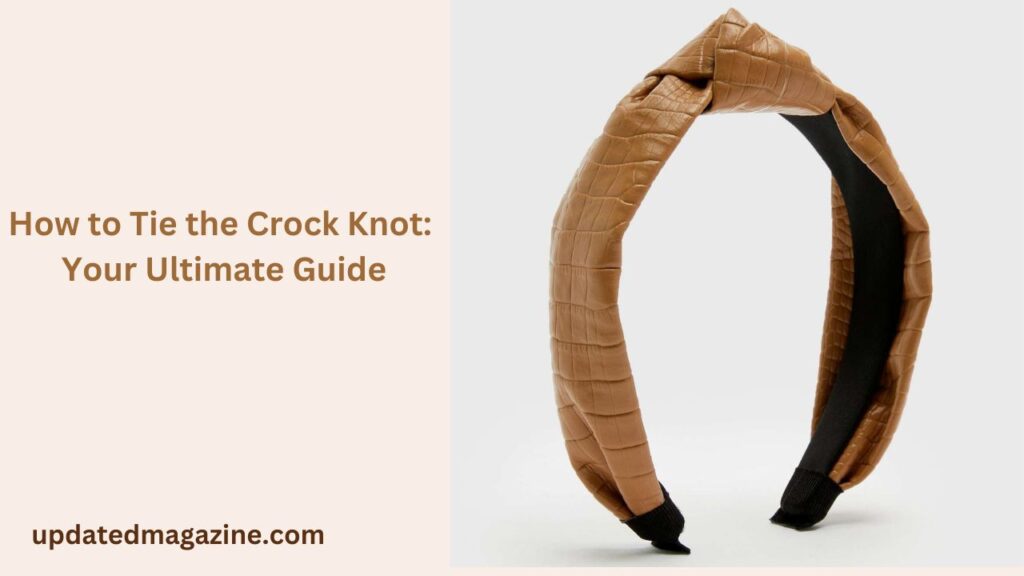Knot tying is a fundamental skill that finds applications across various fields, from maritime and climbing to everyday tasks. Among the multitude of knots available, the Crock Knot stands out for its robustness and ease of tying. Known for its ability to maintain a strong hold under tension, this knot is invaluable for securing lines and loads in critical situations.
Whether you’re a sailor needing to anchor a boat, a climber ensuring the stability of your gear, or a camper setting up a reliable shelter, mastering the Crock Knot can significantly enhance your safety and efficiency. This guide will provide a detailed overview of the Crock Knot, including step-by-step instructions, practical applications, and tips for ensuring maximum security.
Introduction
Knot tying is an essential skill in many fields, from sailing and climbing to camping and fishing. Among the myriad of knots available, the Crock Knot stands out for its reliability and simplicity. This knot is particularly useful in situations where security and strength are paramount. In this article, we’ll delve into the details of the CrockKnot, providing a step-by-step guide to tying it and exploring its numerous applications.
What is a Crock Knot?
The CrockKnot firmly grips and holds under tension, making it ideal for secure connections in boating, camping, and climbing. Unlike some knots that can slip or come undone, the CrockKnot remains tight and secure, making it a favorite among outdoor enthusiasts.
History of the Crock Knot
Sailors and fishermen, needing a reliable knot for securing lines and nets, are believed to have developed the Crock not. Over time, various other communities, including climbers and campers, have adopted the knot due to its versatility and strength.
How to Tie a Crock Knot
Tying a Crock Knot is straightforward, but it does require some practice to perfect. Follow these steps to tie a secure CrockKnot:
Step-by-Step Guide
- Form a Loop: Start by forming a loop in the rope. Ensure the working end (the part of the rope you will be manipulating) is on top.
- Pass the Working End: Take the working end and pass it through the loop from underneath.
- Wrap Around the Standing Part: Wrap the working end around the standing part (the main length of the rope) once.
- Pass Through the Loop Again: Pass the working end through the original loop again, this time from the top.
- Tighten the Knot: Pull both ends of the rope to tighten the knot. Ensure the loops and wraps are snug to prevent slipping.
- Check Security: Before using the knot, double-check that all parts are secure and that the knot will not slip under tension.
Visual Guide
For those who prefer visual aids, a detailed illustration of the Crock Knot can be invaluable. Consider referencing knot-tying guides or videos to see the knot in action.
Applications of the Crock Knot
The CrockKnot is incredibly versatile and can be used in a variety of settings. Here are some common applications:
Boating and Sailing
In the maritime world, the Crock Knot is often used to secure lines and rigging. Its ability to hold under tension makes it ideal for anchoring and mooring.
Climbing
Climbers use the CrockKnot to secure gear and ropes. Its strength and reliability are critical in ensuring safety during ascents and descents.
Camping
Campers find the Crock Knot useful for setting up tents, securing tarps, and hanging gear. Its ease of tying and untying makes it a convenient choice for temporary setups.
Fishing
Fishermen use the CrockKnot to secure lines to hooks and lures. The knot’s ability to withstand movement and tension ensures that catches remain secure.
Tips for Tying Secure Knots
To ensure your Crock Knot holds up under various conditions, consider these tips:
Choose the Right Rope
Different ropes have varying levels of flexibility and strength. Choose a rope that suits the specific application of your knot.
Practice Makes Perfect
Regular practice is essential for mastering any knot. Take time to practice tying the CrockKnot until you can do it confidently and quickly.
Inspect Your Knots
Always inspect your knots before relying on them. Look for any signs of slipping or fraying that could compromise their integrity.
Learn Multiple Knots
While the Crock Knot is highly versatile, it’s beneficial to learn multiple knots for different situations. Each knot has its strengths and best-use scenarios.
Conclusion
The Crock Knot is an essential tool in the world of knot tying. Its strength, reliability, and ease of use make it a go-to knot for a variety of applications, from boating and climbing to camping and fishing. By following the steps outlined in this guide and practicing regularly, you can master the CrockKnot and ensure that your knots are always secure. Remember to choose the right rope, inspect your knots, and continually practice to maintain your knot-tying skills. With these tips and techniques, you’ll be well-equipped to handle any situation that requires a reliable knot.
Frequently Asked Questions
What is the primary use of the CrockKnot?
The Crock Knot is primarily used for securing ropes in situations where strength and security are critical, such as in boating, climbing, and camping.
Can the Crock Knot be untied easily?
Yes, you can easily untie the CrockKnot when it’s not under tension, making it convenient for temporary applications.
What type of rope is best for tying a CrockKnot?
A flexible, yet strong rope is ideal for tying a CrockKnot. Nylon and polyester ropes are commonly used due to their durability and resistance to wear.
Is the Crock Knot suitable for climbing?
Yes, the Crock Knot suits climbing well because it securely holds and reliably bears significant weight and tension.
How can I ensure my Crock Knot is secure?
To ensure your CrockKnot is secure, pull both ends of the rope tightly and inspect the knot for any signs of slipping or looseness.
Are there variations of the Crock Knot?
While the basic CrockKnot is quite versatile, there are variations and modifications that can be made to suit specific needs. Learning these can expand your knot-tying repertoire.
Also Read: Buildapcsales: Find High-Quality Components at Low Prices












